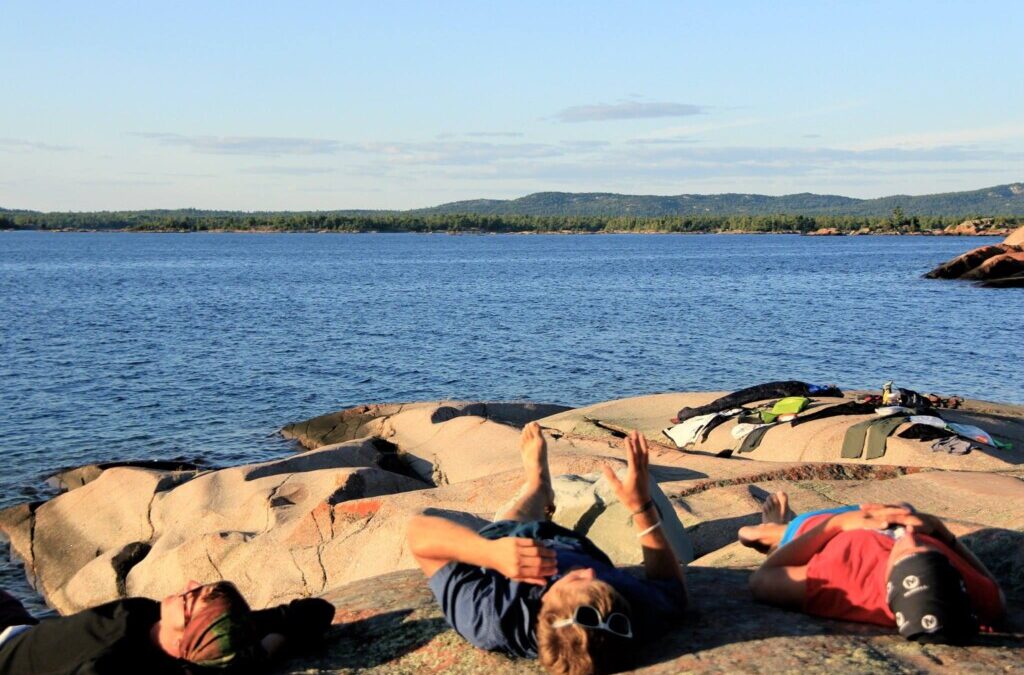Our theme for the month of March is “cities.”
When it comes to long-distance traveling, I don’t make it easy on myself. I regularly forget about knives I have in my carry-on, or large rocks in my pack, or unroasted coffee beans in ziplock bags that look just plain suspicious. And when I don’t have these things in my bag, on the rare occasion that I’ve done everything right, I still get pulled aside for “random” inspections, with the assurance that they do this to every twenty-fifth passenger. Sure you do. Somehow, by some small miracle, I am always the twenty-fifth passenger.
Given this record, I counted it a stroke of luck that a few days before I was to kayak through the North Channel I noticed my passport was expired. An archipelago spanning the northern edge of Lake Huron, the North Channel is—very much so—in Canada, and Canada is, in fact, a foreign country, even to Michiganders, neighbors as we may be.
With mere hours to spare I booked an appointment at the Detroit Passport Agency to expedite my expired American identity. My mom came with me, and we made a day of it, traipsing along the Detroit River while my identity was run through the system and updated. I smiled for the camera, paid eighty bucks (a bargain deal, now that I think about it), and we went on our merry way.
A day later I was northbound on I-75 with my Calvin College first-year orientation crew, watching out the window as the hardwood forests changed to white pines, ferns, and Kalkaska sand. The border crossing at Sault Ste. Marie came and went without trouble, and the day after I was paddling on the open waters of Lake Huron, toward Eagle Island, the Benjamins, and the inlets and rocky beaches beyond.
Setting out on the kayak trip in the predawn hours set the tone for the week ahead. Paddles dipped into the black waters with quiet reverence and a humming anticipation. The rose quartz sun inched over the eastern horizon, turning an indecipherable landscape of shadow into a three dimensional space of cobalt waters and emerald islands.
Two days before I was engulfed in a sea of skyscrapers, business headquarters, and Coney dogs; that morning, I floated on a lake of glass, through a narrow channel of rock, with mournful loon calls echoing off the water and granite, their sound a haunting testament to the lack of human development.
And yet development was there, too. Turbines churned on the horizon, harnessing energy from the steady winds generated across the lake’s broad fetch. Sailboats passed with gas-guzzling support motors and ice chests full of beer. Our kayaks—made of plastic, packed with plastic dry bags, filled with food sealed in plastic—were another constant reminder of our link to industrial society. It was apparent there, as much as anywhere, that the city and the wild are not so separate.
I often think of cities as the foil of wilderness; they are conceptual opposites of one another. Cities are ordered, planned, governed by rules. Wilderness is sporadic, ever changing, and unrestrained, obedient only to the forces of wind, water, sunshine and time. When traveling from the city to the backcountry or vice versa, the smallest elements can serve as reminders of how these spaces are not foils so much as they are inextricably linked, maybe so much so that they are not separate places at all. They are distinct in superficial ways, yes; one has an abundance of Coney dogs, and the other has no toilets. But at their core, both of these spaces are Earth’s; they belong to one another in ways indescribable but clearly visible in the passage of mergansers, the moonlight, and the breath of the wind.
For nights after that kayak trip, while I lay in bed I could still feel the rhythm of the waves, like I was floating in the base of a canoe out into the lake. Those loon calls echoed in my memory, their sound still reverberating in my mind. Looking back on it, I can see how staying in that place for those few days changed me, became a part of me, much in the way the food one eats shows up in one’s cells. I think if I could look closely at my DNA, pull it apart and analyze it in a lab, there might still be a visible trace of the North Channel, of star-filled skies, of friendships formed. And there, in the neighboring sequenced genome, a Coney dog with chili and mustard.
Photo Credit: Jenna Griffin

Jon Gorter (‘17) graduated from Calvin with degrees in English and environmental studies and holds an MS in natural resources from the University of Michigan. He enjoys fly fishing, mushroom foraging, and waterfall scrambling near his home in the Blue Ridge Mountains of North Carolina.


